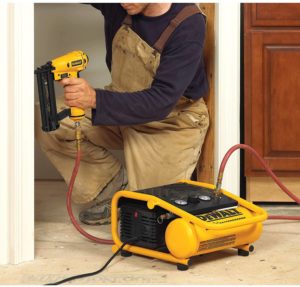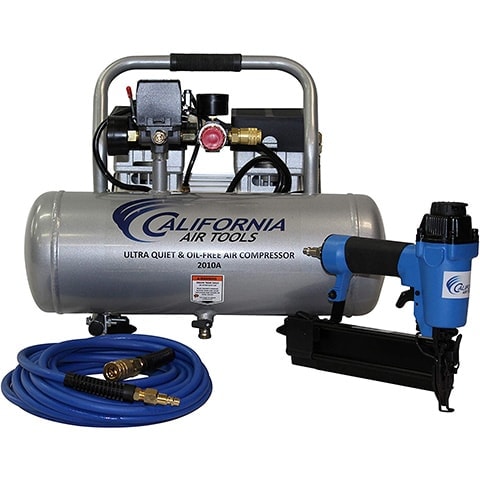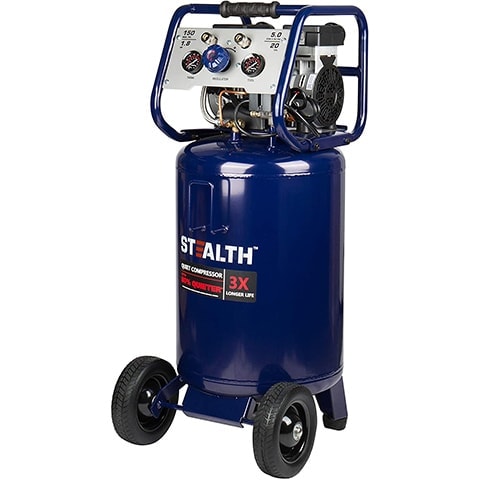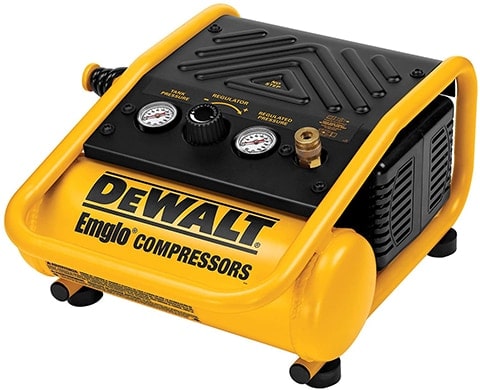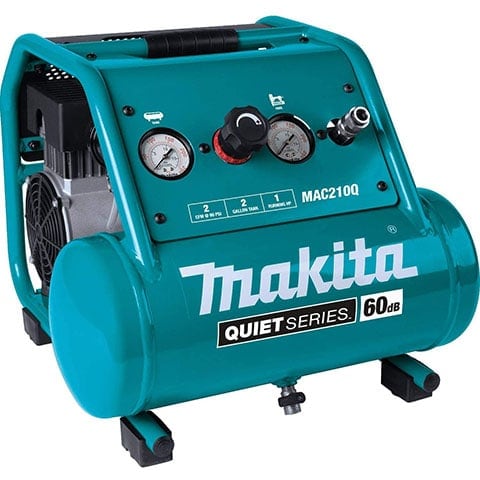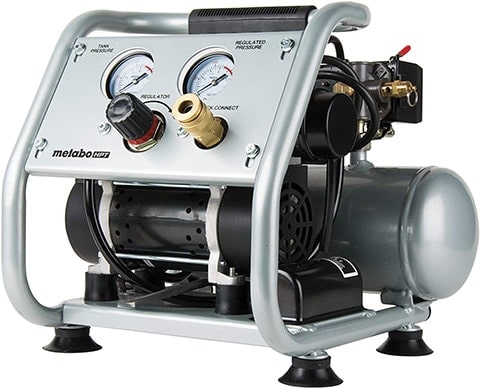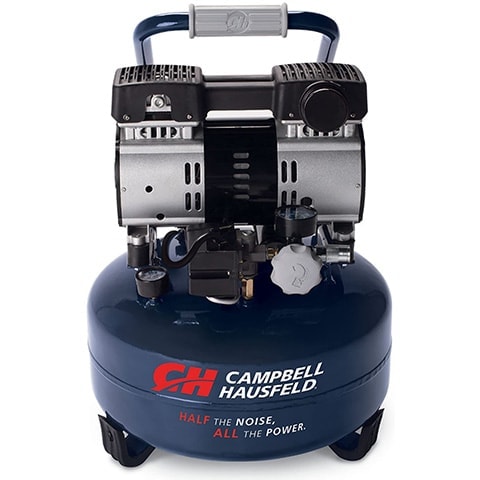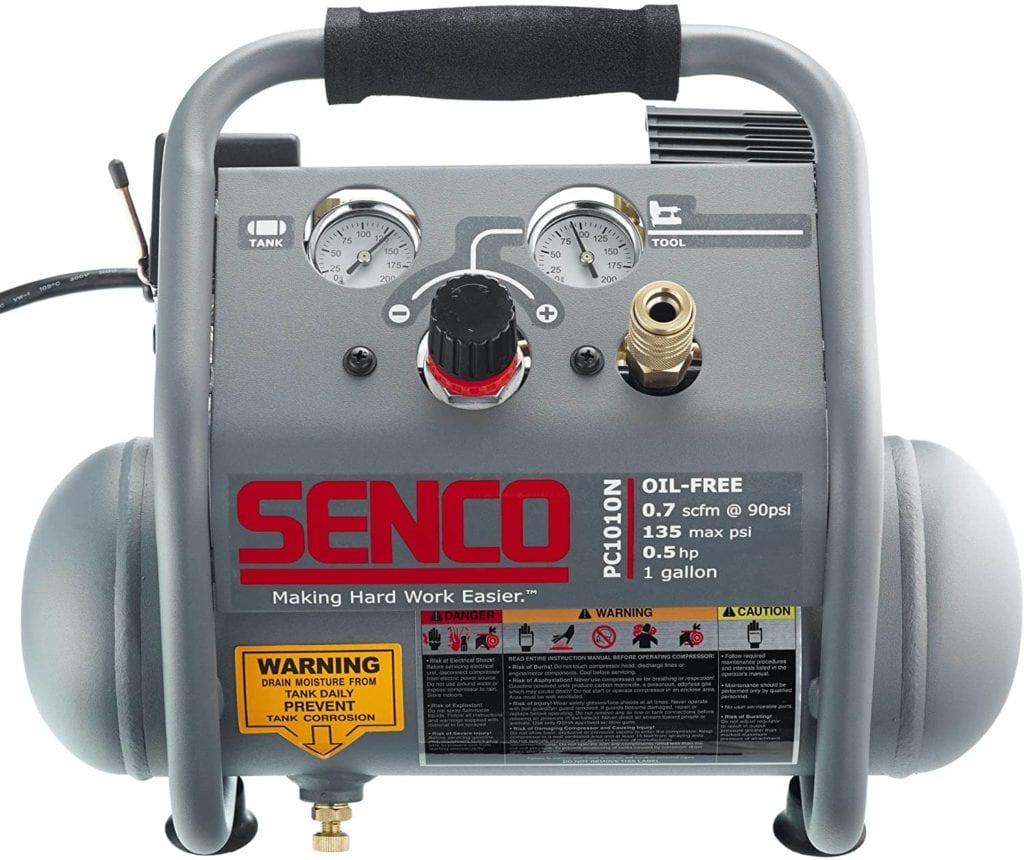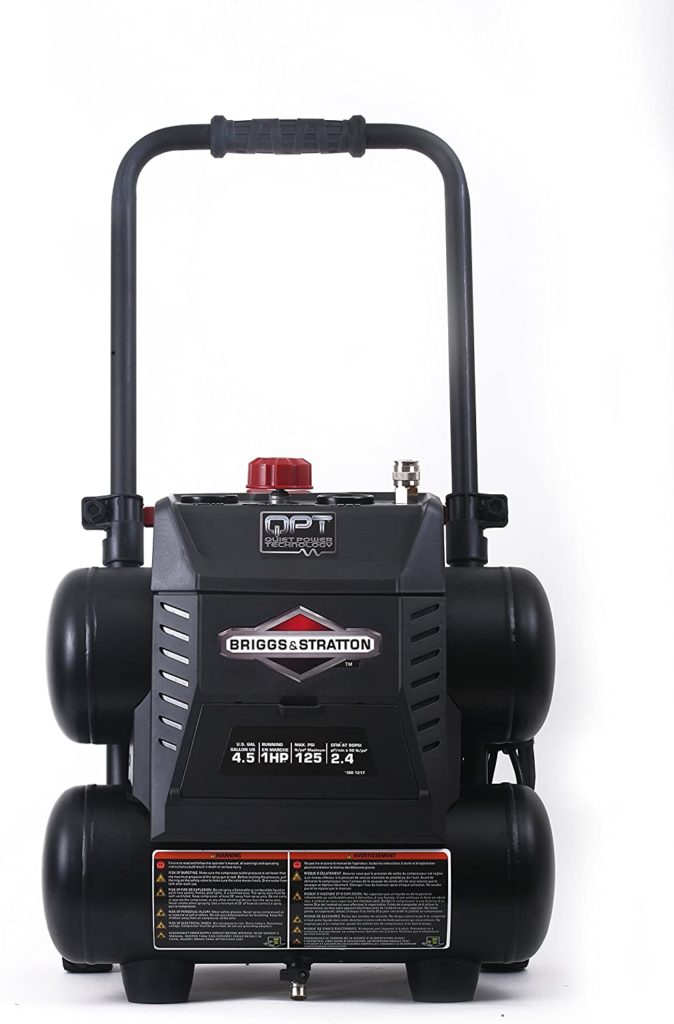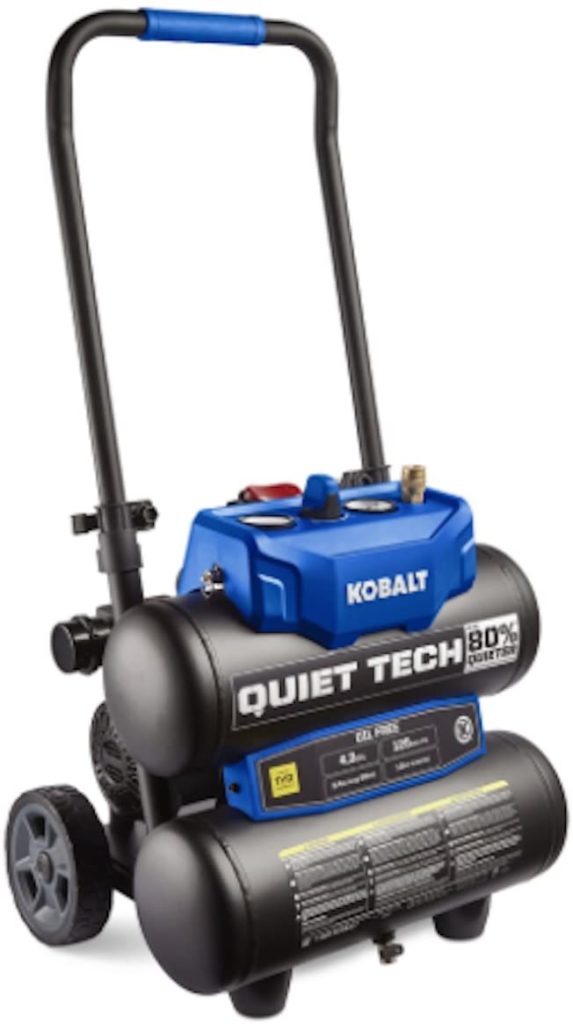10 Best Quiet Air Compressors of 2025 – Top Picks & Reviews
-
Pete Ortiz
- Last updated:

Compressors are a valuable tool that can be used for a variety of purposes. They can be used to power pneumatic tools, paint sprayers, airbrushes, fill tires, detail your car, and a whole lot more. They’re one of the most versatile tools around, but they have one major drawback—they’re loud and annoying!
Everyone who has used a compressor has wished that it wasn’t so obnoxiously loud. Luckily, manufacturers today are able to make compressors quieter than ever before. We wanted to see just how quiet they can get and determine whether these quiet compressors are still as useful as the ones that are as loud as jet engines.
To do this, we decided to test all of these compressors and see how they compare. We don’t want all that hard work to go to waste though, which is why we’ve written the following 10 reviews sharing everything we learned while comparing these quiet compressors.
A Quick Comparison of Our Favorites in 2025
| Rating | Image | Product | Details | |
|---|---|---|---|---|
Best Overall

|

|
California Air Tools 2010A Ultra Quiet Air Compressor |
|
CHECK PRICE |
Best Value

|

|
BOSTITCH BTFP02012 Pancake Air Compressor |
|
CHECK PRICE |
Premium Choice

|
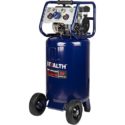
|
Stealth SAQ-12018 Ultra Quiet Air Compressor |
|
CHECK PRICE |
|
|
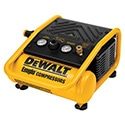
|
DEWALT D55140 Air Compressor |
|
CHECK PRICE |
|
|
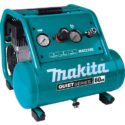
|
Makita MAC210Q Quiet Series Air Compressor |
|
CHECK PRICE |
The 10 Best Quiet Air Compressors
1. California Air Tools 2010A Ultra Quiet Air Compressor – Best Overall
We tested quite a few quiet compressors for this list, and out of them all, the California Air Tools 2010A Ultra Quiet Air Compressor was our favorite. It’s a great blend of quiet and quality, with plenty of power for most pneumatic tools.
This compressor is equipped with a one-horsepower motor that can move 3.1 cubic feet per minute (CFM) of air at 40 pounds per square inch (PSI) and 2.2 CFM at 90 PSI. It operates at a mere 60 decibels (dB); quiet enough to have a conversation right next to it.
One thing we loved about this compressor was the quick fill time of just 50 seconds from empty. It’s got a two-gallon aluminum tank with anti-rust protection. The oil pump is oil-free, eliminating the need for maintenance, and has an impressive 3,000-hour life cycle before wear. All of this weighs in at just 35 pounds, making it easily portable.
Our only complaint about this machine is that the regulator was set too low from the factory. To fix it, we had to disassemble the compressor a bit, though the repair was quite simple overall. Still, we don’t expect to make repairs to a brand-new tool. All in all, we think this is the best quiet air compressor on the market today.
- Operates at a mere 60 dB
- Rust-free two-gallon aluminum tank
- 50-seconds to fill the tank from empty
- One HP motor moves 3.1 CFM at 40 PSI
- 3,000-hour life cycle before wear
- Weighs just 35 pounds
- The regulator is set too low from the factory
2. BOSTITCH BTFP02012 Pancake Air Compressor – Best Value
Affordably priced with some great specs, the BOSTITCH BTFP02012 Pancake Air Compressor might just be the best quiet air compressor for the money. It can reach a max pressure of 150 PSI with a high-flow regulator that’s great for running smaller pneumatic tools with an airflow of 2.6 standard cubic feet per minute (SCFM).
Like many modern compressors, this one features an oil-free, low-maintenance design. It’s got a six-gallon air tank with plenty of volume to keep you working without interruptions. Despite the large tank size, this tool weighs just 29 pounds, making it rather portable.
This machine operates at 78.5 dB. It’s quiet enough to have a conversation right next to, but you might have to raise your voice a little. But for the price, we don’t think you’ll find a quieter compressor with similar specs and all these great features.
- Low-maintenance thanks to the oil-free design
- Six-gallon air tank
- Affordably priced
- Max pressure of 150 PSI
- Weighs just 29 pounds
- Five-decibel operating level isn’t the quietest we’ve seen
3. Stealth SAQ-12018 Ultra Quiet Air Compressor – Premium Choice
With a massive 20-gallon air tank, the Stealth SAQ-12018 Ultra Quiet Air Compressor is one of the largest compressors we tested for this list. Despite that, the entire tank will fill from empty in just 70 seconds, which is faster than many two-gallon compressors we’ve used!
But this compressor offers a lot more than just a big air tank. You’ll get six CFM of airflow at 40 PSI and five CFM at 90 PSI. The total max pressure for the system is 150 PSI. Between the high pressure and airflow, there are few tools that you’ll have a problem running.
Even though this compressor is moving some serious air, it runs at just 68 decibels, making it one of the quieter models we’ve seen. To be fair, it’s also one of the most expensive compressors we tested and it’s pretty large, taking up a lot of space in the workshop. You won’t be taking this compressor from job to job, but for working in the shop, it’s pretty hard to beat this mix of quiet operation, quick filling tank, and substantial airflow.
- Six CFM at 40 PSI and 5 CFM at 90 PSI
- 150 PSI maximum pressure
- Operates at 68 dB
- Extra-large 20-gallon tank fills in just 70 seconds
- There are many cheaper options
- Takes up quite a bit of space
4. DEWALT D55140 Air Compressor
Compact yet capable, the DEWALT D55140 Air Compressor is just nine inches wide and weighs in at only 24 pounds, making it one of the smallest and lightest compressors we tested. It operates at only 69 dB, so it’s one of the quietest compressors we’ve tested as well.
Like many compact compressors, this one features a low-maintenance oil-free design. Also similar to other small compressors, this one has pretty limited airflow, which is what kept it out of our top three. With a weak 0.75 SCFM at 90 PSI, this compressor will have trouble running most pneumatic tools, though it’s a great fit for crafting and airbrushes.
To keep the size small, DEWALT opted for a one-gallon tank on this compressor. You’d think that would mean it fills quickly, but that’s not the case. In our experience, it took several minutes for the tank to fill. But this is a rugged and portable machine that’s enclosed in a roll cage to protect the motor. It’s a great compressor overall, but doesn’t offer enough to dethrone the compressors that placed ahead of it.
- Just nine inches wide
- Weighs only 24 pounds
- 69-decibel operating volume
- Low-maintenance oil-free design
- 75 SCFM at 90 PSI
- Takes several minutes to fill the tiny tank
5. Makita MAC210Q Quiet Series Air Compressor
The Makita MAC210Q Quiet Series Air Compressor is a compact compressor with a two-gallon tank. But despite its small size, it’s pretty heavy, weighing in at 44 pounds. This doesn’t mean it’s not portable, but it does hinder its portability. A lot of that weight likely comes from the roll cage that protects the whole unit, keeping it safe during transport.
With an operating volume of just 60 dB, this is one of the quietest air compressors we’ve seen. Of course, it’s also quite a bit more expensive than similar compressors. Still, it’s loaded with great features like the maintenance-free design and low-RPM operation that helps it achieve a longer lifespan than alternatives.
With two CFM of airflow at 90 PSI, this compressor might have issues powering pneumatic tools. It won’t power anything large like a framing nailer. We even ran into a few problems running finish nailers on this compressor, which is why it didn’t rank higher on our list.
- 60-decibel operating volume
- Surrounded by a rugged roll cage
- Maintenance-free design
- Low-RPM operation for a longer lifespan
- 44 pounds is heavy for a compressor this size
- More expensive than similar alternatives
6. Metabo EC28M HPT Air Compressor
Metabo HPT used to be known as Hitachi Power Tools, but they’re making the same high-quality tools that Hitachi used to be known for. This compressor is a solid offering with a few flaws keeping it from achieving greatness. But let’s start with the good stuff first.
This is a super quiet compressor that runs at just 59 decibels. It’s also compact and portable, weighing just 25 pounds and featuring a convenient carrying handle on top. It needs almost no maintenance thanks to the oil-free pump. Finally, everything is protected by the steel roll cage that surrounds the compressor and rubber feet keep it stable on almost any surface.
Where this compressor falls short is with the quality control and the airflow. This machine only manages 1.3 CFM of airflow at 40 PSI, which isn’t enough to operate most pneumatic tools. Even finish nailers are too much for this compressor to handle. As for quality control, the gauges on ours didn’t work when it arrived. After some investigation, we realized that they were warped, which was preventing the needle from moving. As it turns out, this is a pretty common occurrence with these compressors.
- Super-quiet operating volume of 59 dB
- Steel roll cage protects the compressor
- Low-maintenance oil-free pump
- Very portable at just 25 pounds
- Only 1.3 CFM airflow at 40 PSI
- The gauges didn’t function correctly
7. Campbell Hausfeld DC060500 Portable Quiet Air Compressor
With an operating volume of 68 dB, the Campbell Hausfeld DC060500 Portable Quiet Air Compressor is right in the middle of the pack for operating noise. Its six-gallon air tank is on the larger side though, offering plenty of air to keep you working without needing to constantly stop and wait for the tank to refill. You also get 2.4 CFM of airflow at 90 PSI with a maximum pressure of 125 PSI, which is plenty to run most smaller pneumatic tools like brad and pin nailers.
Naturally, there’s a downside to that larger six-gallon tank; the weight. This is a pretty hefty machine at 60 pounds, even though it’s advertised as a portable air compressor. It’s portable, but not as easily as other models we tried.
Our biggest complaint about this compressor though is the leaky fittings. From the factory, quite a few fittings were leaking, requiring us to take them apart and Teflon tape them. This isn’t a big deal, but we usually expect our tools to work properly out of the box.
- Runs at 68 decibels
- Oil-free, low-maintenance pump
- Six-gallon tank with 125 PSI max pressure
- Four CFM at 90 PSI will run most smaller pneumatic tools
- Pretty hefty at 60 pounds
- Several leaky fittings required Teflon tape
8. Senco PC1010N Portable Hot Dog Compressor
With a 0.5-horsepower motor, the Senco PC1010N Portable Hot Dog Compressor isn’t as powerful as others we tested. You can really tell while waiting for it to fill up since it takes two minutes to fill the tiny one-gallon tank from empty. While working, it will take 30 seconds to recover, so expect to pause and wait for it to catch up pretty often.
Still, this is a quiet and portable compressor, operating at just 68 dB and weighing an easy-to-carry 21 pounds. It’s a maintenance-free design with an oil-free pump, but that’s not enough to make up for its shortcomings.
When we tried to set this compressor to low pressures below 50 PSI, the regulator knob started leaking. We couldn’t get it to stop no matter what we tried. But that must not be the only leak because this machine seems to lose pressure abnormally fast. For us, this compressor caused far more frustration than it was worth.
- Maintenance-free design
- Weighs just 21 pounds
- 68-decibel operating volume
- Takes two minutes to fill the one-gallon tank
- Regulator knob leaks at low pressures
- Loses pressure very quickly
9. Briggs & Stratton 074045-00 Quiet Power Air Compressor
Briggs & Stratton is known for making engines. Compressors? Not so much. But we decided to test their Quiet Power Air Compressor. After all, it looks good and it’s priced reasonably. We were hoping for a pleasant surprise, but we got the opposite.
There were things about this machine we liked. For instance, the oil-free pump that doesn’t need maintenance. It’s also got decent airflow; 2.4 CFM at 90 PSI. But that’s all we have to say in defense of this compressor.
At 60 pounds, it’s a bit of a bear to move. There are tires on the back that make it easier to roll, but good luck if you encounter any stairs! The advertising for this compressor claims it’s 80% quieter than standard Briggs and Stratton air compressors. Well, those must be deafening because this one operates at about 70 dB.
The worst thing about this tool is its operation. It takes several minutes to fill the 4.5-gallon tank. But it doesn’t hold pressure once full. You can actually watch the pressure in the tank dropping. We gave the Briggs & Stratton Quiet Power Air Compressor a chance, but we can’t give it a recommendation.
- Four CFM airflow at 90 PSI
- Oil-free pump for low maintenance
- Weighs a stout 60 pounds
- Not as quiet as the advertising would have you believe
- Slow to fill and quick to empty
10. Kobalt Quiet Tech Air Compressor
We’ve had great luck with several Kobalt tools in the past, so it’s a bit of a surprise that their Quiet Tech Air Compressor finds itself at the very bottom of our list. We’d like to say things started well and got worse, but truthfully, they started bad and got worse.
To be fair, this compressor is pretty quiet with a 60-decibel operating volume. It’s also 60 pounds, making it less portable than other models. There are tires to help out with transportation, but it’s still a bear compared to other compressors that performed better.
Our real issue with this machine though is quality control or the lack thereof. Ours came with a leaky regulator out of the box. It also wouldn’t hold pressure in the tank. Once it reached full pressure, the needle would slowly drop down, even if you weren’t using the air. After some research, we discovered that this is a common problem with this compressor.
To top it all off, this compressor is considerably more expensive than some of the others we tested, even though it offered a sub-par performance. Our advice is to skip this one in favor of something more reliable.
- 60-decibel operating volume
- Weighs over 60 pounds
- The regulator was leaking out of the box
- Tank loses pressure quickly while sitting
- There are cheaper options that performed better
Buyer’s Guide – How to Choose the Best Quiet Air Compressor
When you’re choosing a quiet compressor to power your air tools, you need to first consider what you plan on using it for so you can pinpoint the specs that mean the most to you.
For instance, if you use your compressor to do trim work, you probably need something small and portable with decent airflow. But for running a framing nailer, you need something with a lot more airflow and a bit less portability. If your compressor lives in a workshop powering auto shop tools, then you need something with a huge tank and plenty of airflow, but portability and size won’t matter to you.
To help you determine which traits are most important for your needs, we’re going to briefly discuss the most important specs and features that you should think about in this short buyer’s guide. By the end, hopefully, you’ll know exactly which features you need so you can make an informed decision about which compressor to purchase.
Size and Portability
We briefly touched on size, but this is one of the most important factors to consider, which is why we’re discussing it first. Before thinking about how much airflow or pressure you need, you must decide how large of a compressor is acceptable for you.
First, think about where you plan to use your compressor. Are you going to use it exclusively in your workshop or garage? Is it going to stay in one corner of your shop, or will you be moving it around as you need? Do you work in places that require travel? If so, you’ll need a compressor that will not only fit in your vehicle but one that you can easily lift in and out.
Airflow
Once you figure out how large or small of a compressor is acceptable for your needs, it’s time to determine what tools you need it to power. Pneumatic tools have certain airflow needs that must be met for them to operate. You’ll need to figure out what airflow the tools you plan to use require. Then, you want to find a compressor that offers about 1.5 times that much airflow.
Airflow is measured in CFM or cubic feet per minute. You might also see it measured in SCFM, which is standard cubic feet per minute. Unfortunately, these numbers don’t line up, which can make it difficult to accurately compare compressors from different manufacturers.
So, the real question is; how much airflow do you need? You should look at the specific tools you plan to power for the precise airflow measurements you require, but here’s a chart to give you a basic idea of how much airflow different tools require.
| Pneumatic Tool | Required Airflow |
| 7” Angle grinder | 5–8 CFM |
| Brad nailer | 0.5 CFM |
| Air drill | 3–6 CFM |
| Framing nailer | 2.2–3 CFM |
| Airbrush | 1.5 CFM |
| Roofing nailer | 2–4 CFM |
Fill Time and Recovery
Fill time is the total time it takes for the tank on your compressor to fill completely from empty. Recovery is the time it takes to reach full pressure once the compressor kicks on during use. Both of these are important measurements since they determine how much time you’ll be waiting for your compressor to be ready to work or to catch up with the work you’re doing.
As a general rule, we look for the fastest fill time and recovery possible. We’ve seen 20-gallon tanks that fill up in just over a minute and we’ve also seen two-gallon tanks that take several minutes to fill. This can be a frustrating time-sink, which is why we think this is a feature worth prioritizing.
Conclusion
There are many compressors on the market and most of them advertise “quiet” operation. But through the testing we did for our reviews, we determined that most of them are not as quiet as they’d like you to think. However, we did find three compressors that offered a great mix of quiet operation and usable performance.
Our favorite was the California Air Tools 2010A. This ultra-quiet compressor operates at just 60 dB, weighs a mere 35 pounds, and takes just 50 seconds to fill the tank from empty.
If you’re looking for the best value, we think you’ll find it in the BOSTITCH BTFP02012 Pancake Air Compressor. It’s got a six-gallon tank with a maximum pressure of 150 PSI, yet it weighs just 29 pounds, making it easy to transport.
Finally, with an operating volume of just 68 dB, the Stealth Ultra Quiet Air Compressor is our premium choice recommendation. It offers 6 CFM of airflow at 40 PSI and five CFM at 90 PSI. It’s also equipped with a massive 20-gallon tank that fills in a mere 70 seconds.
See Also:
Contents

